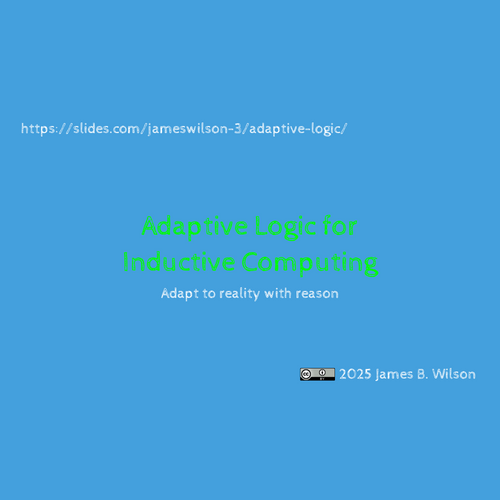
James B. Wilson
Logical Alchemy: Turn False into True.
Chemical Alchemy: Turn Straw into Gold.
Logical Alchemy: Turn False into True.
(L)anguage, (I)ntroduction, & (E)liminiation of \(\Rightarrow\)
If \(x\geq y\) then \(x^2\geq y^2\)
\(x\geq y\quad \Rightarrow \quad x^2\geq y^2\)
if x >= y then
do something!Lets deal with truth and leave computation "if -- then --" untill later,
Rule breaking
\(x^2\geq y^2\), if \(x\geq y\)
When \(x\geq y\) it follows that \(x^2\geq y^2\)
if = when= because ....
then = implies = follows = thus...
Non-implications that use the same language
A triangle is equilateral if all its sides have equal length.
Term being defined
"If" used to separate equivalent clause
Definitions are names/symbols to substitute often lengthy or technical expressions, e.g. \(x:=\sqrt{17}^{\log 541}\)
(L)anguage, (I)ntroduction, & (E)liminiation of \(\Rightarrow\)
If it rains then the ground is wet.
\[\begin{array}{rl} \Gamma & \vdash P\Rightarrow Q\\ \Gamma & \vdash P \\ \hline \Gamma & \vdash Q\end{array}\qquad (E_{\Rightarrow})\]
(E)LIMINATION
"Modus Ponens"
It rained.
Therefore the ground is wet.
Premise
Conclusion
\[\begin{array}{rl} & P\Rightarrow Q\\ & P \\ \hline & Q\end{array}\qquad (E_{\Rightarrow})\]
(L)anguage, (I)ntroduction, & (E)liminiation of \(\Rightarrow\)
If \(x\geq y\) then \(x^2\geq y^2\)
\[\frac{P\vdash Q}{ P\Rightarrow Q}\qquad (I_{\Rightarrow})\]
(I)NTRODUCTION
\(\Gamma\): Natural numbers \(m\geq n\) means there is a \(k\) where \(m=n+k\)
\(m\geq n\) means there is a \(k\) with \(m=n+k\)
P
Q
Process states \(\Gamma,P\vdash Q\)
If \(x\geq y\) then \(x^2\geq y^2\)
CONTEXT MATTERS
If \(-3\geq -4\) then
\((-3)^2=9\geq 16=(-4)^2\)
In the natural numbers, if \(x\geq y\) then \(x^2\geq y^2\)
In the integers, \(-3\geq -4\) but
\((-3)^2=9\geq 16=(-4)^2\)
\[\frac{\Gamma, P \vdash Q}{\Gamma \vdash P\Rightarrow Q}\]
\(\Gamma\)
\(\Gamma\)
If -- then --
<imp> ::= if <term> then <term>
<imp> ::= <term> => <term>
\(\langle imp\rangle ::= \langle term\rangle \Longrightarrow \langle term\rangle\)
\[\frac{\Gamma, P\vdash Q}{\Gamma \vdash P\Rightarrow Q}\qquad (I_{\Rightarrow})\]
(I)NTRODUCTION
(naive version)
\[\begin{array}{rl} \Gamma & \vdash P\Rightarrow Q\\ \Gamma & \vdash P \\ \hline \Gamma & \vdash Q\end{array}\qquad (E_{\Rightarrow})\]
(E)LIMINATION
(naive version/ modus ponens)
(L)ANGUAGE
Logical Alchemy: Turn False into True.
If -- then -- (Vagueness)
If pigs can fly then pigs can get bird flu.
This is a valid statement because pigs can can get bird flu.
However, pigs cannot fly.
What explains this situation?
If -- then -- (Vagueness)
If pigs can fly then pigs can get bird flu.
It is seems illogical to argue that a false premise leads to a true conclusion
What explains this situation?
False Premise P
True conclusion Q
However context is always available as well!
Context (maybe implicit) may be responsible for true conclusion, i.e. \(\Gamma \vdash P\)
Classical & Intuitionistic context even have \(\bot \vdash Q\)
If -- then -- (Vagueness)
False Premise P
True conclusion Q
\(\Rightarrow \)
This is a confusing abbreviation of reality.
Instead read this as:
Context, or
False Premise P
\(\Rightarrow \)
True conclusion Q
Since context is often implicit never forget to ask if context is responsible for implications.
Summary
- False \(\not\Rightarrow\) True,
- but Context implies True \(\Gamma \vdash \top\) and context is always around for implication.
- This is still a naive take on implication, several things are still to consider
- Process (Intuitionistic) vs. Incidence (Classical)
- Resource counting (Linear logic)
False does not lead to truth, but context might
By James Wilson
False does not lead to truth, but context might
Implication is how we take one truth and turn it into a new one. It is enjoys a special place in science as the reason we do hypotheses and the mechanism to compute. However not everything about this operator is immediately obvious.
- 197



